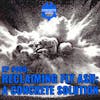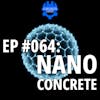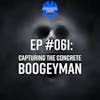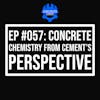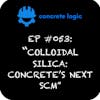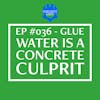EP #036 - Glue Water is a Concrete Culprit
Flooring can be a sticky situation for concrete contractors on construction projects. When the flooring won't adhere to the concrete or if the installed floor starts to bubble up, guess what gets the blame?
That's right - the concrete!
In this episode of the Concrete Logic podcast, Dean Craft of ISE Logik Industries shares his insights on the flooring industry. Dean opens our eyes to who is really controlling the concrete moisture testing standards and why flooring warranties are a mirage.
Concrete contractors and suppliers do not want to miss this episode!
Episode References
Guest: Dean Craft | ISE Logik Industries | decraft@iselogik.com
Guest Website: | https://iselogik.com/
Music: Mike Dunton | https://www.mikeduntonmusic.com| mikeduntonmusic@gmail.com| Instagram @Mike_Dunton
Host: Seth Tandett, seth@concretelogicpodcast.com
Host website: concretelogicpodcast.com
Seth: [00:00:00] And welcome to another episode of the Concrete Logic Podcast. And today I have Dean Kraft with ISE Logic Industries. Dean, could you give us an introduction?
Dean Craft: Thanks, Seth. Thanks. Well, like you said, my name is Dean Kraft. I'm one of the principals and owners of ISE Logic Industries. Our focus is to proactively address the issue of moisture vapor emission.
So that's the residual moisture in the concrete coming out and causing issues with directly installed flooring roofing coatings. Been in the industry about 15 years. I think it's at least part of my background. I'm on the committee that writes the standards for flooring. It's the ASTM F6 committee on resilient flooring within that committee.
I'm the technical author of a published standard. It's already out and available, and it's for substrate surface porosity. [00:01:00] I'm the technical author of a second standard that just got approved that should be come to print here shortly. And I'm also on the ASTM D8 committee for roofing and waterproofing, and I have another standard working that way through now.
It's getting ready to go out to full ballot. So not only are we a manufacturer, we're really trying to also improve the industry overall. On issues that affect trying to stick something to concrete, right?
Seth: So, let's explain what we're trying to prevent and achieve here. So, we might not.
Make a whole lot of flooring friends today. So, let's, explain to the audience. Why? Why? 1st of all, why is it important to understand the moisture coming out of the concrete. Why is that important?
Dean Craft: Well, if you look at the history and it's funny if you talk to, I won't [00:02:00] say old timers because that probably applies to myself as well now.
And it's a double-edged sword because a lot of the, younger generation coming through, all they've known is the current situation of adhesives, low VOC. But if you go back over 30 years, that's when the glues took a significant change. So back in 1992 due to changes and scrutiny by the EPA big, concern arose over indoor air quality, I.A.Q. Then became I.A.Q. Indoor environmental equality issues. In other words, VOCs in the built environment. Harming us leading to elevated out elements or elemental cases of asthma, respiratory stress. So, as it works in the built environment, one of the culprits was identified as the adhesives used to stick down flooring.
So that was one of the first ones that really took a lot of scrutiny. [00:03:00] So what occurred in 1992, there was a pretty fundamental and massive shift in the formulation of the adhesives. In other words, more basically, they went from a much higher VOC content adhesive to a water-based adhesive. And more, more simply think about super glue.
That would be a high-VOC adhesive. It can basically be cured in almost any kind of environment. And then think about Elmer's glue. That's a water-based adhesive. So, if you're a woodworker and you're trying to work in high humidity environment, that, that wood glue is going to take a lot longer to set up than if you were using that, same glue and say the high desert of Utah, same glue, same wood, but the ambient conditions affected differently.
So long and short of it is when, the industry went from high VOC adhesives to low VOC adhesives. They changed the solvent. [00:04:00] Water is the universal solvent. Water became the primary ingredient to allow that adhesive to spread. And the flooring system with the concrete, it does not handle it well if there's excess water.
So that really drove the scrutiny on the moisture. What happened then the installation instructions did not change. Massive failures occurred throughout the 90s. And then in 1998, the flooring industry, not the concrete industry, came up with a requirement that the concrete had to be tested. So think that through.
The flooring industry changed the adhesives, did not change the installation instructions. And then six, seven years later, they turned around and pointed to the concrete. So that's the history of what happened. And unfortunately, like I said, we're talking 25, 30 years ago, and most people in the industry now do not know that.
Seth: Unintended [00:05:00] consequences. Again, hit this.
Dean Craft: Yeah. So think about this. Think about if you are like Elmer's glue Elmer's glue. It's a great glue, but if you use gobs and gobs of it with paper, it's going to create a, like a goopy mess. And now think about a glass tabletop or in this world, think about powered trowel concrete.
It'll get a nice, sheen, it's going to tighten up the surface. That becomes a non-porous substrate. So if you're trying to glue something to that nonporous substrate and resilient flooring is very thin. You can put glue down with a paint roller, but if you put too much glue down and then you lay down that resilient flooring, where does the excess moisture go?
It has no place to go. It can't soak in the concrete. You've basically sealed the surface. And there is literature going back again, 20 plus years that clearly shows that there is more than enough [00:06:00] adhesive in some of these water and some of these adhesives that the water itself from the glue can induce the failure.
So, when they did not change the installation instructions, and they kept applying these glues in high humidity environments or with the big, notched trowel and put too much glue down, yeah, it was a moisture failure. The problem was is nobody knows, was that a moisture failure from the concrete or was it a moisture failure because there was too much water in the glue.
That all got steamrolled, they focused on the concrete, and that leads us to where we are today.
Seth: Gotcha. So it sounds like glue is similar to concrete in the fact that concrete is a very local. Locally based material, meaning that you got to think about the environment you're putting concrete in. Is it the same for the glue?
Dean Craft: Oh, absolutely.
Yeah, actually it's fantastic. So think about ACI 305 [00:07:00] hot weather, concrete products, ACI 306, cold weather one of the things let's go back to concrete. Let's specifically ACI 305, hot weather. A lot of projects focus on well, we're not above 80 or 85 degrees so therefore we're not in hot weather conditions.
But if you actually look at ACI 305, there is an evaporation calculation. So technically speaking, you could be at 40 degrees ambient, but if you've got 20 mile per hour wind and you've got no wind break and you've got high no, no cloud cover and you've got low humidity. Okay. You better have an evaporation retarder out there.
You better be taking steps to slow that evaporation rate, or the surface of that concrete is going to be compromised. And a lot of times, projects don't take that into account, specifically with the cold weather, hot weather situation. They think, because it's another off repeated thing, well, hot weather is 80, 85 [00:08:00] degrees or above.
If you read 305 carefully, it's really driven towards evaporation rate. And it's the ambient conditions, as that drive that. So just like flooring, it's the ambient conditions that are going to drive specifically the proper curing of a water-based product, like the example I gave for woodworking.
If you're in central Florida where I live in August and you're in my garage, that glue ain't never going to dry. Dry. If we jumped on the Star Trek transporter beam and took it to high desert of Utah. It's going to set up quickly, all driven by ambient conditions. But if you ignore that, it can lead to, again, just like concrete, if you ignore the simple ambient conditions, ambient temp, ambient humidity, wind speed substrate temperature over the ground with concrete, it can lead to some really bad situations.
So your parallel with concrete is very [00:09:00] similar to adhesive. Very similar.
Seth: Yeah, so let's, talk about a typical project as far as I guess if, we were doing it the traditional way, and then we'll get into other ways to tackle this. But in the traditional construction method, we would go out there and we would put the concrete down. The full structure or concrete on top of a metal deck or whatever. And then there's a process that we got to go through after the concrete's put down to prepare that concrete substrate for the flooring. Say we're putting flooring down on top of it. In office building or multifamily or hospital, big one, right?
Schools. Can we, can you walk us through what that traditionally looks like? And then we can talk a little bit [00:10:00] about the issues that occur on every project.
Dean Craft: Absolutely. And actually, before I begin, we were talking before I want to bring up something that you said in your experience in history, what have you noticed in the specs?
Like in every single project, what have you noticed regarding this issue?
Seth: Oh, okay. Yeah. Well, in the specs, there's always some kind of reference to making sure that the concrete mostly the, whatever say, retarder, evaporation, retarder, any cure, any form release any of those products.
Oh, yeah big, yeah, have to, you have to. Coordinate those with the
and make sure it's compatible. So there's you just concrete guys, we get all that [00:11:00] information. There's we use, typically we use the same, list of materials, every job those, materials and, we throw them all together and then we send them on to the GC and GC sends them on to the architect and architect reviews it.
And I would say they hit they, stamp it and say they, looked at it review, but then they'll put a note on there that says must be coordinated with flooring contractor. So you end up having this meeting with the flooring contractor and you walk through all the different materials that we use and depending on the timing of that meeting more likely there's already been concrete put down.
Right? So there's our product and cured. Yeah, exactly. So the concrete's already been put in place. So we're talking about something that's already occurred and, [00:12:00] long story short any issues with the flooring going down, usually ends up somewhere on our lap at some point.
But what I guess what we, need to talk about is. I guess the process.
Dean Craft: That's actually, very excellent to start with because remember just like when you guys go out there to place a slab on ground the requirement for a vapor retarder an ASTM E1745 product correctly installed by ASTM E1643.
That's really the prep for traditional slab on ground. That's the start. If that's done correctly, then obviously quality mix, screeded formed. Finish correctly coming up. The source of that concrete becomes the substrate surface for what [00:13:00] follows. So the things you spray on it, the evaporation of water, the curing compound, et cetera, depending on what's how they're made could affect what's being stuck to it.
Seth: And what a lot of people in the finish too.
I forgot to mention that.
Dean Craft: Well the finish. Okay. One of the, I remember I said, I wrote I'm the author. The finish is actually a complete aberration misnomer where the flooring industry is blamed the concrete industry for something that is a very, easy work around.
So any finishers out there, please pay attention to this point right here. One of the ASTMs I authored is called ASTM F3191. It is the measurement of the surface porosity absorption of that concrete surface. The reason why it's so important. Let's say you guys get out there and you burnished the heck out of it so you can shave in it.
That's a non-porous surface. And actually, I would offer to you that more than a few passes with your equipment, especially if it's a double fan out there, which is the weight gives you a great surface, [00:14:00] but it's going to densify that surface face. A couple passes. It's going to be non-porous.
Here's the test. It's a drop of water, 60 seconds. If it doesn't soak in, it's nonporous. The flooring industry or some of these flooring subjects are saying, oh my God this is terrible. It's we can't install on this. Not true, because there are plenty of adhesives that will bond to a non-porous substrate.
And so not only did I write the standard for the flooring industry to use. It's now a requirement for all resilient flooring to be installed, the slab surface to be pretested for substrate porosity. I'm also one that got that in the requirement. This is not a concrete issue, because the normal process for finishing concrete is the power trowel.
It's good for you guys’ labor, it's good for your amortization of equipment, it's good for just process. So most [00:15:00] likely new concrete is going to be non-porous. So this is actually, this is one of those process changes that fundamental understanding that the industry needs to grapple with. Assume with new concrete, the slab will be non-porous.
Even at the pre slab, just assume it because you're going to be using power trowels. But it's not something necessarily going to be a detriment. It just means then the flooring installer may either have to Alter, maybe you have to grind the surface to open it up or simply pick a different glue. So now go back to 1992 when they changed the glues.
The VOC glues did not soak in. They dried very quickly in almost any environment. But when they went to the water-based glues, a lot of those adhesives had so much water, that water needed to go someplace. The flooring [00:16:00] industry did not come out with substrate absorption testing in 1992. That ASTM was not published until 2016, almost 25 years later.
So as a process, spreading a water-based glue on a non-porous substrate and then sealing it with a resilient flooring, you've trapped water in the concrete or in actually the above the surface and below the backing of the flooring. So let's go back to this. How you finish it. Actually, I there's an article recently wrote for the Construction Specifier.
Construction Specification Institute. They kind of discussed this. Really you have to assume that it's going to be non-porous. But it's not a bad thing. There are different glues that they can use. It's but it's important thing. For all in the project to understand and even a lot of the slab prep materials like skim coatings, imperfections or whatever or leveling compounds, [00:17:00] some, if it's nonporous, simply say, oh, you got to prime it first.
So it doesn't mean it's like, oh, my gosh hair fire since you and I both bald hair fire running around all this crazy stuff. No it's, fairly, should be fairly easily and directly be able to dress without going crazy. Well when you and I were talking before, we talked about a 200,000 square foot project bed tower, and this is how important this is.
The flooring manufacturer spec said selected adhesive as recommended by the manufacturer. Of course, that manufacturer wants their glue to use. It's another SKU. They can make a little more money. We researched it. And the glues they recommended said only for a porous substrate, if nonporous, bead blasts self-level so you can use this kind of glue.
Well, bead blasting and self-leveling is about $3.50 a square foot. [00:18:00] So that the GC would have found out right at time of installation that they're looking at a $700,000 change order and extra weeks. We noted that. The architect changed that language to select an adhesive suitable for substrate surface condition and compatible with flooring backing.
That's part of the contract to the GC. So the GC goes, Nope, we're just going to pick a different glue. That's what happened. No bead blast, no self-level, unless it was messed up. All warranties conveyed, no extra charge to the project. So again, this whole thing about how the concrete's finished. That is, that, that is a complete misdirection.
There's lots of products that can go down on a power trowel concrete. Very important for the concrete sub to understand as you try to support the GC and keep the project going. There's a lot of products out there. It just has to happen some [00:19:00] certain language in the 09 to empower the GC to just pick a different glue or pick a different underlayment.
Okay. So great point. Now let's go to how it's cured. There’s ASTM C309, which really is your, self-dissipating compounds. They absolutely can be used safely, but the GC needs to understand that there might need to be a caveat to where the flooring contractor may have to just scuff up the surface a little bit with like think about the scratch pads on the bottom of a flooring buffer that can scratch off to make sure it's all removed because you may not have the right UV to break it down or foot traffic or whatever.
It's a quick thing you can remove. The key, though, is it can't be petroleum based. So you can definitely use C309 curing compounds but, you gotta be careful what's made of, to make sure it can be removed. Then there’s your C 1315 Cure and Seal [00:20:00] products. The cure and seal if you read C 1315, part of being recognized as a C 1315, cure and seal is an adhesion test, a bond test.
Those products have already gone through a bond test. If used properly, again, another misnomer, misunderstanding that's been pushed down by the flooring industry is that you can't use a curing compound. While curing seal is permanent, it's going to go back to give you that non poor substrate. So, if it's properly applied and not puddled where you may have some silica salts or whatever.
All you do is the water drop test and then go back to what I said before, just follow the non-porous substrate installation instructions. But why are all this pressure? Why all this discussion about burnishing the concrete? Or you can't use a curing seal? It has nothing to do with concrete. It has to do with the liquid products containing water because the flooring industry [00:21:00] Was not doing porosity tests.
That's what it goes back to in proper installation instructions to completely match up with those kinds of products.
Seth: So are, is the porous and the non-porous adhesive is there a difference in price or something? Is that why the flooring contractor chooses it?
Dean Craft: Great, question.
Let's go back to people just not knowing. Cause actually the crazy thing is. There are plenty of these he's out there that if you look at the data sheet, it'll say literally if the slab, if the substrate is porous use, and then this is use the big notch trial and wait this amount of time.
Okay. It is nonporous to use the tiny notch trial or a paint roller and, then do this way. Literally there's plenty of these [00:22:00] products that are absolutely suitable for either porous or non-porous. You just got to change which trowel or your open time. Same thing with your slab prep materials, like products a feather finish, a skim coat, that's going to you have some scratches or whatever, and they're going to, they're going to put this material and they can go on very thin.
There's products out there that'll bond perfectly fine to a non-porous substrate. There are other manufacturers that will not, that require a bead blast or a primer, extra cost, extra time. So. I can't stress enough to the design team and the general contractors to understand just because your slab is nonporous and it will be, does not mean you have to go down this very expensive path of bead blasting and self-leveling.
You can just pick a different glue or a different primer or [00:23:00] a different prep material. Yeah. Or just change your installation instructions for the same product.
Seth: Right. Well, before they put it down, they, do a test in the field, right? What's the test?
Dean Craft: Remember, let's go back to history.
The adhesives changed in 1992. The documented process to how to evaluate substrate surface evaluation did not come in until December 2016. It became a requirement for all slabs to be evaluated, July of 2021, almost 30 years after the products changed. So just think that through how many products out there were the product simply being installed wrongly because the requirement to measure the surface absorptivity wasn't there. [00:24:00]
Think of how many things got blamed on the concrete because that simple test was not there. Let me ask you, you ever painted before, painted drywall before?
Seth: Unfortunately, yes, I do. I do not like painting.
Dean Craft: Yeah, you me both. Okay, so we can look for somebody else to do it. We'll sit there and drink beer or something.
Okay. Simple question. Silly question. What's going to take more paint, unprimed drywall or well primed drywall?
Seth: Which is going to take less?
Dean Craft: More.
What's going to take more paint?
Seth: Oh, the unprimed.
Dean Craft: Why? Because it's porous. Right. So what's going to take more glue? A porous surface, a substrate concrete surface, or a non-porous?
Seth: Yeah, porous, so.
Dean Craft: But if you spread that same amount on a non-porous, which most concrete slabs will be, you are literally installing that product wrong. [00:25:00] And then it become a, that did not become a requirement to test until July 2021. So think how many decades in between.
Seth: Have you seen on a job where a GC has required the manufacturing of the adhesive or the flooring to watch an installation?
Dean Craft: Oh, yeah. Yeah. There's another ASTM called ASTM F 33 53, 33 55 or is it 33 11? It's a standardized field bond test. Can't stress that enough. Most flooring manufacturers actually have it embedded in their literature.
They either recommend or require a bond test. And the bond test is nothing more. Let's say like resilient sheet. You gotta do a two by three-foot square foot. You prep the slab correctly, you put all the material down as if you're doing a full install. You put it down, you come back three days later, and you pull.
That's all you're doing. [00:26:00] Often overlooked. Perhaps one of the most important field evaluations that can be done. You do it for all your flooring products. Everybody stands around. They see the pool. Yep. That worked. That worked. That worked. That worked. Okay. Flooring contractors do the same thing everywhere.
We shouldn't have a problem. So it's really important to do it because then it's proving that, hey, there's nothing wrong with concrete on the surface. The prep was good. Everything's compatible. So the problem manifests later on in some other areas. Okay.
The product was installed differently, but more importantly, let's go back to this porous, non-porous thing. I've actually stood there and watched where an adhesive, a non-porous an adhesive that was good for porous and non-porous. When the installer, the flooring installer was using their trowel, [00:27:00] when they came back with their arm, they kind of overlapped.
And so in certain areas, there was more adhesive than others when they put the resilient sheet in within a very, short amount of time, as we're standing there, watching off gassing bubbles formed and when they peeled it back, those bubbles were directly underneath where the adhesive was double applied, and it can manifest just that quickly.
So that's how important it can be depending on the glue being used. And that was at a health care facility that we stood there and watched it happen. And I was the one that noticed it. And I said, that's where I see back butter. They, overlapped. They did it again and were very careful. Lay the flooring down, roll it.
No bubbles appeared. Had you not known what you were looking [00:28:00] at? That easily can be blamed on concrete moisture, and it had absolutely nothing to do with the concrete. It all had to do with how that trowel was used and that particular glue and that particular flooring. But if you did not know that that healthcare facility could have been charged five, six, seven dollars a square foot to mitigate for concrete moisture, an issue that did not exist.
So, I mean, it's just it's a big deal to know how these products are being installed and how they're supposed to be installed. And we think about what you said, all this focus is on the concrete. You guys got to make sure you're curing compounds suitable for flooring industry. Who's driving all that?
That all came from the flooring requirements. Where's the requirement to make sure they're doing what they're supposed to be doing? That doesn't [00:29:00] exist.
Seth: I couldn't tell you because I typically don't read the flooring spec.
Dean Craft: well, that's should you and know what I expect you to, but just understand the reason why that language is that y'all have to comply with where it came from that came from the flooring industry.
That's where it comes from. That's where it's being driven by.
Seth: what's the moisture content requirement. Where, does that stem from? Because I know over the last handful of years, the guy that some of the companies that sell the maturation meters you.
take all the temperature, the probes.
Yeah, so some of I forgot which company what was 1 or 2 of those companies were trying to sell you that. Hey, this also measures the moisture content of concrete.
So when it's okay to put the flooring down and I had maybe one G.C. reach out when we were looking at a particular job and they said, hey could, you look and see if this is something we should use?
Dean Craft: Well, okay. Again, the devil's in the details. So ACI, American Concrete Institute, there's a document, there's a guide for the design of, concrete slabs to receive moisture sensitive flooring.
ACI 302. 2, pretty specific document, right? I mean that is the guide for the design of these kinds of slabs, roofing, flooring, right? In that document. And the first iteration of the document is 2006. It just got reviewed. I think the new iteration is coming out for 2022. It says very clearly, there is no relationship between the RH of the [00:31:00] concrete and the adhesion of resilient flooring.
So then why is there such a big thrust to worry about the RH of the concrete? Where, which industry Came up with that test.
Seth: Not the concrete guy can tell you, not the concrete guy.
Dean Craft: So if it wasn't the concrete guy who came up with that test.
Seth: The floor, but yeah, I don't understand again, they're just, are they just trying to mitigate any liability.
Dean Craft: I told you when we talked before, I actually did my doctoral dissertation on this subject, and it went a lot through a literature review to try to deconstruct the process of whether or not testing for moisture before you install flooring or roofing is actually a value add process doesn't really lead to what the design build owner [00:32:00] communities believe it does.
And if you go back again to 1992, They changed the glues, massive failures. I would postulate, and I don't think I'm wrong, is that a lot of those failures were predicated on trying to use a water-based glue in the same manner they used VOC adhesives. And a VOC laden adhesive you can put down in 98% humidity, high temp, low temp, it's still going to cure properly.
The water-based adhesive, absolutely not. And so if you follow the timeline, those changes occurred in '92. The requirement to moisture test came from the flooring industry, and that became codified in 1998, which is also the first year that the flooring industry codified the calcium chloride test as an ASTM.
Four years later, 2002, the RH test became a codified ASTM. So the timeline is important. The glues changed; concrete didn't change. [00:33:00] Massive failures occurred. Flooring industry or the concrete industry was oblivious because y'all, were just doing y'all's thing.
But on the flooring side, the flooring industry turned and drew attention to the concrete and did not draw attention to the adhesive changed and installation instructions not changing. So these 2 tests became codified. And so, by the same token, every spec you go through, and you see that it's a requirement to make sure that the curing compound is compatible or, gosh forbid the surface of the concrete, how it's finished is compatible with what's going to be installed.
On the flooring 'side they got driven into every single flooring spec, the requirement, the concrete be tested for moisture. So that requirement was driven by the flooring industry, not by the concrete industry, using tests written and overseen by the flooring industry, not the concrete industry, [00:34:00] driven through the spec. And now it’s endemic in every single project out there.
Just like what you see on the concrete side there's, certain things you see in every spec moisture testing is in every flooring spec. But again, you support and understand where did that process come from? It originated out of the failures in the 90s that the flooring industry was faced with by changes they made, not the concrete industry, but somehow, they got to focus on the concrete.
Not on their products. The insidious thing is, if you dive deep into the tests themselves, the calcium chloride test and the RH test, the standards are very clear. The results are only valid at the time of the test. No flooring. Water based adhesive. Water based cementitious prep material. So you have this [00:35:00] dry surface, then you spread some liquid on it, that's obviously going to change the moisture content.
Then you cover it with an impervious flooring cover. So if it does fail in the future, what the flooring industry is going to do is come in and test that for moisture. Obviously, it's going to be higher, and they're going to say, Oh, it's from the concrete. Wait a second. All you're telling me is the moisture content changed, but that doesn't tell me where the moisture came from.
Nobody talks about that. And then the last comment, if you play it through, one of the biggest points that the flooring industry is used to get this embedded into every single spec is this threat that if you don't pass the moisture test, you can't get the warranty. All any designer or GC needs to do is simply look at the warranty from that manufacturer.
Manufacturers warrant manufacturing defects in almost all cases. [00:36:00] They have what's called exclusions. Very clear. Moisture is always excluded. So to wrap all that up, the glue has changed because of EPA VOC requirements. The installation instructions did not. Massive failures. The flooring industry came up with a requirement to test in '98, the flooring industry came up with the test methods in '98 and 2002, the flooring industry has since evolved too, to threaten that if you don't pass these tests, you can't get a warranty. All for an issue that if you read the warranty is not covered, you got it.
You laugh. There you go. That's it is all laid out. That's the current process that the, it's like a dog chases a tail. The GCs. I mean, we can go into other things, too. There’s literature out there that most likely the cockpit cannot even pass this test. I mentioned before, there's literature out [00:37:00] there, ACI literature that the tests aren't even related to adhesion.
So most likely the concrete cannot pass, not related to adhesion and not covered by a warranty. So the, bigger question is for your audience base should be, well, why are we doing this process?
Seth: We can ask, but more than likely we won't change the process. So what can we do as contractors and suppliers?
Dean Craft: well, I would offer you change it by one at a time and what we do is we provide a path that the projects can change that process. So if our product goes in the concrete, so. We're going to, we're going to compare this to, a regular project. You're Baker, you're there on site. Concrete trucks come in.
As far as you're concerned, there's no difference. [00:38:00] Truck pulls up. We're there. Solutions already there. Or you may have a project and we call it the tale two projects or our products not there. And then the project has to go through everything we just described. Well, if our products are there. The process has already changed because what the project team can do is they can go into the flooring spec, and they can remove the requirement to moisture test.
The project documents are written and driven by the architect and the consultants. They're not written and driven by the manufacturer. That's, based on the legal general conditions. The architect and their consultants decide. Not the manufacturer. And that's one of those little things that keeps getting missed.
So if done correctly, you take a product like ours and you put it in the 03 spec so that you guys know it's there, that the Ready-mix producer knows it's there. But concurrently, you go [00:39:00] into the O9 spec and remove the requirement to moisture test. Why? Because you've already picked a solution that's warranted 100%.
Once that's done, now the process goes through. Y'all do your work, you finish it, you, whatever, then the GC can actually send to us the entire flooring submittal and all these things we talked about is porosity an issue or ambient conditions an issue? Is adhesion an issue? We review that for the project, and we put it in writing to include, by the way, to include during compounds.
Seth: But doesn't, but going, getting away from that process, that's in the specifications.
Does that not void that warranty that we, I guess, through our discussion on this podcast, does that hold any water?
Dean Craft: It's a funny thing too, about a spec. If you look at a lot of different [00:40:00] product specs in part one, cause these three parts specs in part one, the architect can simply add 1.8 warranty, standard manufacturing defect warranty shall convey. Contract document now.
Seth: But if it sounds like the warranties that are out there are pretty much null and void because no one's really following what it says anyway.
So what we're saying is,
Dean Craft: but it's manufacturing defect.
Seth: Right, but what I'm getting at is I think people need to get over get, over the fact that this warranty is, there, but it's not really doing anything for you.
Dean Craft: unless the manufacturer made the product wrong.
Seth: Right, but what we're saying is we need to start thinking about solutions that provide a [00:41:00] superior result or superior product at the end where you don't have problems and you don't need to use a warranty.
So there's what pops in my I don't know if you ever seen the movie Tommy boy. Tommy boy about the warranty that popped in my head.
Dean Craft: So Ohio, right? Wasn't that Sandusky or
Seth: He tells you about what he thinks about warranties. It's, quite hilarious, but anyways, so I
Dean Craft: Probably can't repeat that here.
Seth: No, well, I have to change things on all these podcasts.
Anyhow, so what we're saying is we need to stop jumping through all these hoops to make some, what we think. We're, applying or we're following the, orders of the of the warranty. We are doing what the warranty is asking us. At least we thought we were,
Dean Craft: we thought we were. Yes.
Seth: Yeah. So what we need to think about is how do, we deliver a product that will function and do what it's supposed to do at the [00:42:00] end of the job so we don't have to worry about the damn warranty, correct. That's what we're getting at. Correct. So what you're saying is your company will review all these the specs and the documents, the submittals and in there and, suggest a solution that provides a result that everyone can be happy with.
The owners happy. You don't have floors bubbling up. You don't have adhesive not doing what it's supposed to do. That's what we're driving at today. Is that's what we need to start looking at. Yeah. And that's not only applies to what you do, Dean, but also applies to a lot of things that we do as a concrete industry across the board.
We’re all jumping through hoops to make someone happy that's written something down that we think we're doing ourselves good.
Dean Craft: Well, [00:43:00] correct. And so with the warranty thing and the process thing 1st of all, if you're anybody ever whether it's in your own personal life or whatever, if somebody starts threatening a warranty, you might want to go pull the warranty out and read it.
Because again, the flooring manufacturer warranty. You may get some labor or whatever, but it only applies their warranty only kicks in if there's a manufacturing defect. That's when their warranty kicks in. So, whether you take that that, that, flooring product and install it correctly, or whether you put it in the bottom of your parakeet cage.
That's what they cover. Now, if it doesn't, if it fails in the bottom of your parakeet cage, we're like, well, that's not the intended use. You can put it in your parking lot and drive all over it. Hey, the flooring all tore up. They're gonna come out there and say, not intended use. But they warrant manufacturing defect.
And they're gonna say, yeah, it looks terrible. It's all torn up. But we didn't make it that way. [00:44:00] That's what they warrant. So the simple question is, why are projects allowing themselves to jump to those hoops, chase the mythical unicorn of a past moisture test for an issue that's actually not covered?
Step back and just slow down and say, okay, looking from the owner's perspective, and this goes back to what you were saying about, deliver, that quality product, but flooring is not bubbling, et cetera. What does the owner want? And I've, done this before I asked does the owner wants a passing RH test or does the one owner want what you said that flooring delivered on time on budget and that performance way is supposed to? I would offer the owner wants the second one.
And low maintenance that goes to the product selection. Yeah, right. That's what the owner wants too often. People say, well, I have to have the low RH. No [00:45:00] wait, which one do you want? Well, I want the second one. Okay. That's easily achievable. That is definitely achievable.
But if you keep thinking that you have to chase this, metric, that's not even tied to that. ACI says it's not tied to it. The flooring industry itself says there's no warranty for it. The test itself tells you it's only point in time. And crazily enough, we mentioned the RH test. The RH probe is less than the diameter of a quarter.
And this test is one per thousand square feet. Okay. Okay. I'm glad you're laughing. So the test says it's only valid for the exact location of the test. So the room you're in right now is way less than a thousand square feet, but just put a quarter down there and look at all the other areas not being tested.
So just from a rational perspective, how then is that quarter [00:46:00] relevant to the 99. 999% of the substrate surface that's not being tested? But that's what's written. Point in time, the exact location. So think that through by the plain language of the ASTM document that you're chasing, unless that failure occurs right above that quarter, then the simple out for the flooring industry, well, that area wasn't tested.
Read the documents. It says very clearly, and then read the warranty. There's no warranty exclusion blah, blah, blah, blah, blah. Moisture. Yeah. So again it's, if once people understand that they can be doing this as well as rolling the dice or flipping a coin or doing a dividing rod. But make the manufacturer warrant that they made their [00:47:00] product correctly.
That's easily put into a spec.
To try to allow a manufacturer to circumvent that they made their product correctly by what you do with it on your project. Those, aren't associated. It’s not rocket science, but it's just everybody slow down, stop chasing, jumping through hoops.
And just say, "Wait a second." You look at all the documents together.
You know, if we go to process, if we enter this process here, we're not coming out where we think we are. And that's why this keeps perpetuating because people aren't slowing down and stepping back and just simply looking at the documents that is based on and therefore, they keep going through this.
But I can tell you right now, you change this process. It fundamentally alters project delivery. We did a massive project. You mentioned Ohio. We did a project just out of Columbus several [00:48:00] years ago. The GC evaluated the inclusion of our admixture and following this process saved about three months in the construction process.
You used to be at design build. I know you're a Baker. What do you think the value is that owner and G. C. by shaving off 3 months in the construction process on a 600,000 square foot hospital?
Seth: Got to get those butts in the beds to make money. So there you go.
Dean Craft: Yeah, I must say they didn't lose it someplace else.
But 3 months and that 3 months was associated with. Testing, waiting for the results, retesting meetings, and then mitigating by simply changing the process. By the way, all warranties conveyed, they got their manufacturer's warranty. They got the installer's warranty. They got a warranty against moisture from us, and they got an adhesion warranty from us.
By simply changing the process.
Seth: Yep. So that's how the concrete [00:49:00] producers and contractors can help these GCs and owners out.
Dean Craft: Absolutely. And in fact, you mentioned the producers. A lot of the producers CIP, shout out to NRMCA, the concrete in practice, the simple documents, the two-page documents one through five is for cracking.
CIP 28 from the National Ready Mix Concrete Association is called concrete moisture. In that document is actually list is a moisture production admixture is one way that the concrete industry can offer up a proactive way to address this issue as opposed to not being involved not benefiting, not getting paid for an issue that is concrete issue and leaving it for after the fact for the flooring industry.
So absolutely, this is absolutely a way for the concrete industry to, to be a part of a proactive solution in support of the GC in support of the owner, as opposed to leaving this to an industry that's [00:50:00] completely disassociated.
Seth: Right, and that's the key. I think the key word there is proactive.
So that's something that we struggle with all the time. So let's give that a go. Dean. I think Dean, let's pause it for today. If folks want to reach out to you and learn more about your company and your product what's the best way?
Dean Craft: You can go to our website iselogik.com. You can go to contact. My name is right there. I'm one of the principals. I'm one of the owners. I sign on our warranties. You can reach out to me. They can find me through you and I'm letting right now I'm fully authorized Seth to share my contact info. So don't mind at all.
If you have an organization that wants us to come in and talk, we routinely have Lunch and learns is one [00:51:00] thing, but we also have more focused project delivery discussions directly with GC's design build. So if you want us to come in, we'd be more than happy to, but I guess the easiest way since people know who you are I fully authorize you to share my information.
Otherwise go to our website and we'll be happy to help however we can.
Seth: Yeah, we'll so when we release this, we'll put your info on the show notes and people we also have and if you all aren't part of our newsletter group you can go to concretelogicpodcast.com and sign up for our newsletter.
We got a bunch of folks that get our weekly newsletter too, so we'll get. We'll get you on that list, Dean. And then others that are listening, please do that as well. Dean, I appreciate coming on the show today. And I hope we do it again soon. [00:52:00]
Dean Craft: Sure. Thanks, Seth. Enjoyed it.
Thank you so much.

Dean Edward Craft
Principal / Retired Marine
Dean Craft, LtCol USMCR (ret.), DBA, ASTM is a Principal with ISE Logik Industries and a leading specialist in proactively addressing concrete moisture vapor emission issues in new construction concrete and existing slabs that will receive moisture sensitive flooring and roofing. Dr. Craft completed his doctoral work with a dissertation entitled “Fallacy of Current Industry Approach to Assessing Concrete Moisture Before Flooring Installation”. And, as a member of both the ASTM Committee D08 on Roofing and Waterproofing and the ASTM Committee F06 on Resilient Floor Coverings, he is the primary author and technical chair of the following international standards:
• F3191 - Standard Practice for Field Determination of Substrate Water Absorption (Porosity) for Substrates to Receive Resilient Flooring (published 2016)
• F3441 - Standard Guide for the Measurement of pH Below Resilient Flooring Installations (published 2023)
• FXXXX - Standard Practice for Fluid-Applied Membrane-Forming Moisture Mitigation Systems for Use Under Resilient Floor Coverings (currently undergoing balloting)
• DXXXX - Standard Guide for Evaluating the Substrate Surface of Structural Concrete Roof Decks to Receive Adhered Roofing Systems (currently undergoing balloting)













